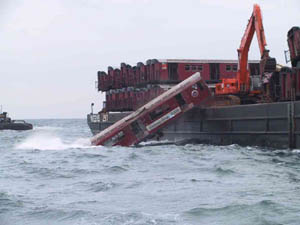
In 2003, 150 subway cars from the New York City Metropolitan Transit Authority (MTA) made their way to Virginia. Although there has been talk of a light rail system for Tidewater, these cars were bound for a deeper purpose, literally! For over 27 years, Mike Meier, director of VMRC's Artificial Reef Program, has been locating appropriate materials for use as artificial reefs and suitable locations on which to sink them. Virginia's Artificial Reef Program receives much of its funding from the Virginia Saltwater Recreational Fishing Development Fund and is one of the most popular programs funded by these license monies.

November and December of 2003 saw the arrival of two shipments of subway cars, which were deployed off the northern Virginia Coast. Prior to being loaded on board barges for their trip from MTA's 207th Street Overhaul Shop on the banks of the Harlem River, the cars received extensive preparation. Each car was stripped and cleaned according to a protocol developed by MTA and approved by the US Environmental Protection Agency and the US Coast Guard. This protocol included removal of window glass, petroleum products, pneumatic, electrical and refrigeration equipment, doors, and anything that might float. The cars were then washed down. After this work was completed, Mr. Meier inspected each car, along with representatives from MTA and the Coast Guard. Any discrepancies, of which there were only one or two, were corrected immediately and the cars were re-inspected. As they were loaded on to the barge, the cars were separated from the trucks (wheels for you non-Casey Jones types). This project started as the brainchild of MTA's Assistant Chief Operations Officer, Asset Recovery, Michael G. Zacchia. Mr. Zacchia had a big problem - what to do with hundreds of subway cars, long known as "Red Birds", that had to be retired. These cars are various ages, many of them almost 40 years old. It was time to start replacing the fleet but room had to be made as new equipment came on line. After investigating numerous alternatives such as re-sale and scrapping, he came up with the idea of "reefing" the cars. He learned that coastal reef programs are always looking for structure that is durable, stable, will provide a surface for fouling organisms and interior habitat for fish such as tautog and black sea bass. Further research with environmental authorities indicated that the cars could be prepared so as to make them environmentally friendly. His idea made good sense. It was tough going at first, but the State of Delaware was the first to jump on board, followed by Virginia, South Carolina and Georgia.

The subway cars were deployed on three of Virginia's offshore reefs, Tower, Blackfish Bank and Parramore. Buoys were stationed on selected deployment locations. At Blackfish Bank Reef, which is off Chincoteague, cars were placed in several clusters. At Parramore Reef, off Wachapreague, cars were sunk in two very irregular pairs of parallel lines (running roughly NE &SW) between and around buoys stationed at four positions. 25 cars were sunk in each line. These patterns differed due to the depth contours at each site and weather conditions (translate that to mean sea state - rough seas knocked the windshield out of one of our crew boats). One of our main concerns was to avoid having cars landing on top of each other. Mr. Meier is currently working on at least one more deployment further down the Virginia coast. Most recently, theTower Reef (southwest of Chesapeake Light - off Virginia Beach) received its share of 50 subway cars. Now, there are three reefs that will be ready for some spring tautog or black sea bass fishing. All three artificial reef sites are marked on NOAA charts and are depicted in the Virginia Saltwater Anglers Guide.

